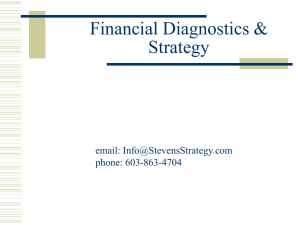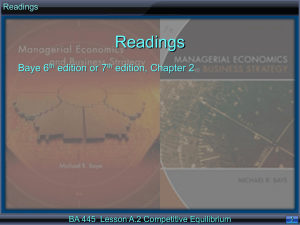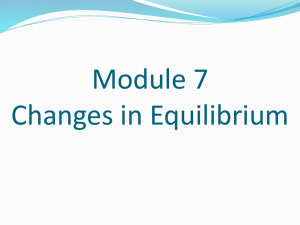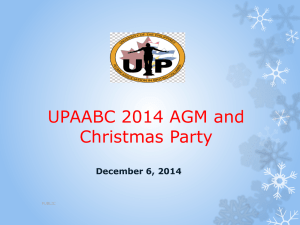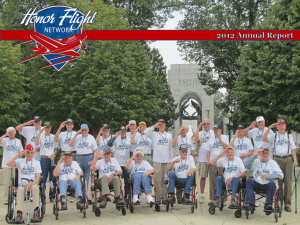Financial Distress Strategy and Management
advertisement
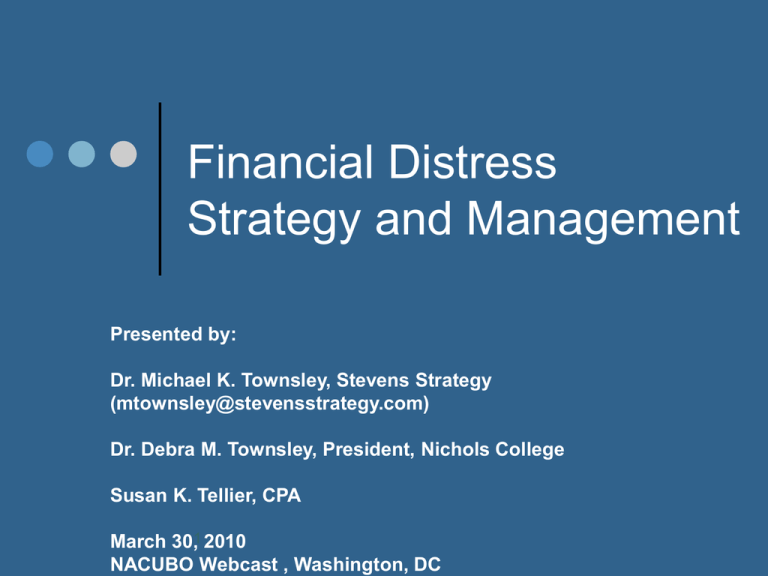
Financial Distress Strategy and Management Presented by: Dr. Michael K. Townsley, Stevens Strategy (mtownsley@stevensstrategy.com) Dr. Debra M. Townsley, President, Nichols College Susan K. Tellier, CPA March 30,1 2010 NACUBO Webcast , Washington, DC Financial Distress Agenda Definition of Financial Distress Financial Distress Conditions Financial Distress Metrics and Tools Financial Distress – Turnaround Strategies and Management Long-Term Financial Management Management Reporting Case Study – Nichols College’s Turnaround Takeaways Measuring Financial Distress Department of Education Scoring Index Equilibrium Grid 3 Types of Financial Distress Episodic Financial Distress is a temporary lapse caused by deficits and happens when unexpected changes take place in the market or in government regulations or in purposeful budgetary allocations. Chronic Financial Distress is not a temporary lapse into deficit spending but a continuous and pervasive condition. 4 Financial Distress Conditions Financial distress does not typically appear overnight. Credit lines provide patchwork liquidity solutions, and the credit lines are growing over time. Lenders are reluctant to grant new loans or to revise covenants. Vendors, payroll tax withholdings, and payroll benefit withholdings are not paid or forwarded on time. Proportion of student bills categorized as uncollectable represent a growing proportion of receivables. Deficits extend over a series of years. Net assets have declined significantly over many years. The Department of Education issues a letter requiring a credit line to cover 50% of financial aid. 5 Financial Distress Metrics 1. Net from operations after deducting unrealized and realized gains or losses has been negative for two or more years and is growing in scale. 2. The college is dependent on a credit line to cover regular cash disbursement. Typical metrics for evaluating cash adequacy are: the cash ratio of cash to liabilities with a 0.50 benchmark and cash to expenses with a 0.33 benchmark (about 3 months). 3. Net assets are declining in scale. Set up a trend chart to compare net assets. 4. Working capital (current assets minus current liabilities) is negative. Put together a simple working capital chart to measure working capital. The net should be zero or positive. 6 Financial Distress Metrics, [Continued] 5. The US Department of Education (DOE) Financial Responsibility Index is less than 1.50. Track your DOE scores using the DOE rules. 6. The DOE penalty requires a letter of credit to offset a portion of the federal funds. 7. Composite Financial Index Score is less than one (1.0). 7 Financial Distress Tools with Examples • Operating Net Adjustment for Unrealized & Realized Gains/Losses Adjusted Operating Net ($000) FY #1 Operating Net $2,300 Deduct Unrealized & Realized Gains/Losses3,200 Adjusted Operating Net ($900) FY #2 $1,800 2,200 ($400) FY #3 ($3,000) (1,500) ($1,500) • Working Capital Working Capital Example ($000) Current Assets Current Liabilities Balance Ratio FY #1 $2,000 1,900 $100 1.05 FY #2 $1,750 2,100 ($350) 0.83 FY #3 $1,500 2,200 ($700) 0.68 • Cash Ratio Cash Ratio ($000) Cash and Short-Term Current Assets Current Liabilities Ratio FY #1 $500 480 1.04 FY #2 $460 500 0.92 FY #3 $490 530 0.92 Benchmark > 0.50 8 Financial Distress Tool Composite Financial Index (CFI) The CFI combines four key ratios into a single measure of financial condition. The values of the four key ratios are combined through a set of weights and factors to produce the CFI score. The CFI score is a broad measure of the state of the institution. It does not require comparison with a peer group. 9 Financial Distress Tool Composite Financial Index Scores are placed in a scaling range to indicate degree of financial health. Scores greater than three are strong indicators of financial strength. Scores of one or less suggest that the college is in a fragile financial position. 10 CFI Monitors Four Critical Measures of Financial Risk Primary Reserve Ratio measures operational risk Expendable net assets to expenses Net Income Ratio measures short-term risk Net operating income to operating revenue Return on Net Assets Ratio measures risk to production of wealth Change in net assets to total assets Viability Ratio measures long-term debt risk Expendable net assets to long-term debt 11 Computing CFI Score with Strength and Weights Ratio Value Primary Reserve Net Income Operations Return on Net Assets Viabilirty Ratio / Strength Factor Strength Value X Weight Ratio Scoring X Ratio / 0.1333 Strength *0.35 = X Ratio/ 0.0070 Strength * 0.10 = X Ratio / 0.0200 Strength * 0.2 = X Ratio / 0.4170 Strength * 0.35 = 12 Financial Distress CFI Scoring Guide SCALE LEVEL CFI SCORING RANGE One -1 to 1 Two 0 to 2 Three 1 to 3 Four 2 to 4 Five 3 to 5 Six 4 to 6 Seven 5 to 7 Eight 6 to 8 Experiment with new initiatives Nine 7 to 9 Experiment with new initiatives; achieve a robust mission Ten > 9 ACTION Assess viability of institution's survival Reengineer the institution Direct resources toward transformation Focus resources to compete Deploy resources to achieve a robust mission 13 Financial Distress Tool Department of Education (DOE) Financial Responsibility Test The purpose of the test determines if the college has adequate financial resources. Scoring Parameters are: Score less that 1.5 and greater than 1.0 falls into the zone of warning; results in a letter of warning. Scores less that 1.0; requires a line of credit for 50% of the financial amount available to be awarded by college. 14 Financial Distress Tool Department of Education Index Department of Education Ratios are: Primary Reserve (similar to CFI) Net Worth (net assets/total assets) Net Income (unrestricted net income / unrestricted revenue). Ratios are also adjusted by a set of strengths and weights. The strength and weight factors are on the Department of Education site. 15 Financial Distress Turnaround Strategies First Step: Collect financial, enrollment, and operational data. Second Step: Determine the source(s) of financial distress: 1. Student markets. 2. Financial aid discounts 3. Shrinking value of gifts 4. Major declines in investments 5. Revenues growing faster than expenses 6. Check the components of the Composite Financial Index Ratios to identify where problems exist. Third Step: Estimate the gap between your current condition and financial equilibrium. Fourth Step: Develop specific plans based on the Second Step and the scale of the gap identified in the Third Step. Fifth Step: Put the plans into operation and carefully and continuously monitor performance. 16 Long-Term Financial Strategy Goal: To reach long-term financial equilibrium. Two Components of Equilibrium: Cyert Equilibrium Model • Equilibrium occurs when a college has adequate resources in quality and quantity to support its mission. • Equilibrium is reached by: - Operating at or above breakeven; - Maintaining the purchasing power of liquid assets; and - Maintaining the quality of fixed assets. • College must determine the scale of its equilibrium gap. • Focus of strategy development should be to eliminate the gap over time. Hopkins and Massey Equilibrium Model • Long-term growth rates for revenue equals or is greater than long-term growth rates for expenses. 17 Case Study Nichols College The turnaround strategy started in 1998, during Debra Townsley and Sue Tellier’s first year at the College. What follows were the financial conditions at Nichols College prior to and during the turnaround. 18 Enrollment from Turnaround to Current Fiscal Year Full-Time Undergraduates 1400 1200 1000 800 600 400 200 0 1998 1999 2000 2001 2002 2003 2004 Fall Semester 2005 2006 2007 2008 2009 19 CFI Scores from Turnaround to Current Fiscal Year 4.50 4.00 3.50 3.00 2.50 2.00 1.50 CFI Score 1.00 0.50 0.00 FY 1998 FY 1999 FY 2000 FY 2001 FY 2002 FY 2003 FY 2004 FY 2006 FY 2007 FY 2008 FY 2009 20 What Was the CFI – Turnaround Strategy Our CFI was .43 in 1998, and is now about 3.20. How was this turnaround accomplished? Multi-faceted approach No sacred cows Communications essential 20 Board Involvement— Your First Priority Had 100% of the Board support. Rebuilt the Board, including the bylaws. Asked the Board to vote on tough issues. Included more alumni on the Board. Paid senior staff at market levels to get the best. 21 Communications Provide Fall/Spring open employee forums with updates and Q&A session. Offer a January State of the College address. Share financials with the College Community (shared deficits with all in the first two years). 22 Communications [Continued] During turnaround period, met with each department as a group and with each faculty member individually on where we’ve been, where we’re at, where we’re going. (This has been replaced by fall and spring College meetings.) Insisted that no employee speak about the College closing to the students or the external public and brought them to task if they did. 23 Financial Planning Did budget model in year one for five years – critical for bond approval and for Board approval – and noted the College would run a deficit for up to four years. Therefore, the College did not slash programs. Continue to use and update the financial planning model. Planned by our motto: Under promise and over achieve. 24 Entrepreneurial Approach Acted and continue to operate entrepreneurially – did not stand on academic tradition. Attacked turnaround from all angles and hoped something would work. 25 Increased Revenue Pursued new markets – CED, MBA, online. Expanded undergraduate day enrollments. Offered new academic programs in hot fields. Raised tuition to level of the competition. Raised gifts –conducted a comprehensive campaign. Increased student retention. Began summer programs. Sold excess property. 26 Decreased Expenses Revised budgets and held staff to the amounts assigned to their budgets. Returned to core competencies – got out of golf course management and faculty housing. Closed nonperforming functions, like a conference center. Reorganized for efficiency, performance and customer service – saved positions through attrition. 27 Decreased Expenses Eliminated programs with low enrollments. Offered early retirement incentive programs (ERIPs) to faculty. Adjusted faculty salaries so that they were equitable. Implemented post-tenure review and merit pay. 28 Decreased Expenses Used contracts (MA Higher Ed Contract Assoc., COWC Contracts, State Contracts). Froze salaries – only equity adjustments. Managed fringe benefits, including raising health care employee contributions to a percentage so employees share in future increases. Developed a master plan with facility needs which created long-run expense savings; we spent money to do it right. 29 Increased Net Assets Shifted out of equity investments to fixed income; subsequently, the College returned to an equity/fixed income mix. Set a policy: Half of cash surplus annually goes into unrestricted net assets and half into physical plant and deferred maintenance. Issued bonds to build two buildings and to do deferred maintenance without decreasing cash on hand. 30 Increased Net Assets (expendable net assets) Established a cash management program so that money was not sitting in a checking account. Paid off line of credit – paying 8% but earning 6%. Negotiated with banks to get the best deal – now with a local bank and get higher service and lower cost, and we are a big customer to them. Set a student collections plan to improve cash flow. 31 Worked on “Curb Appeal” Refinanced old bonds at a lower rate to make “curb appeal” improvements. Concentrated on improvements that would improve the attractiveness of the College. (See the following pictures of improvements in the last ten years.) 32 Old Residence Halls Replaced Merrill Hall being taken down. 33 Copper Beech I and II (Suite Residence Halls) 34 Academy Hall 35 Conant Hall Exterior Renovations 36 View of Campus Common 37 Athletic Center 38 Budleigh Hall 39 Conrad Hall 40 Nichols College Case Study Summary Turnarounds are possible, but not easy. Most important factor is having Board support. Second most important factor is explaining the problems and offering solutions. Try many things. Some of them will work! 41 Financial Distress Take Aways Department of Education and CFI References CFI computation form CFI Scoring sheet Department of Education computation form Cyert Equilibrium Grid Hopkins and Massey Equilibrium Grid 42 Department of Education and CFI References Department of Education References: Ratios: http://www.ed.gov/finaid/prof/resources/finresp/finalreport/edlite-ratios1.html Strength Factors: http://www.ed.gov/finaid/prof/resources/finresp/finalreport/edlite-strengths1.html Weighting Factors; http://www.ed.gov/finaid/prof/resources/finresp/finalreport/edlite-weights.html Score: http://www.ed.gov/finaid/prof/resources/finresp/finalreport/edlite-compositescore1.html CFI Reference: Strategic Financial Analysis for Higher Education, sixth edition; KPMG; Prager, Sealy and Co,LLC; Bearing Point; Washington DC; 2005 43 Financial Distress Tool Composite Financial Index (CFI) PRIMARY RESERVE add unrestricted net assets add temporarily restricted net assets subtract property, plant, equipment (net of depreciation) add long-term debt numerator = total expendable net assets denominator = total expenses Ratio = NET INCOME USING UNRESTRICTED ASSETS add unrestricted operating revenue subtract unrestricted operating expenses numerator = net operating income add total unrestricted revenues and gains add net assets released from restriction denominator = total unrestricted operating income Ratio = RETURN ON NET ASSETS numerator = change in net assets denominator = total net assets (beginning of year) Ratio = VIABILITY add unrestricted net assets add temporarily restricted net assets subtract property, plant, equipment (net of depreciation) add long-term debt numerator = expendable net assets denominator = long-term debt Ratio = CFI SCORING (uses strengths and weight measures) Primary Reserve Net Income Return on Net Assets Viability CFI Score 44 Financial Distress Tool Department of Education (DOE) Financial Responsibility Index 1 PRIMARY RESERVE add unrestricted net assets add temoprarily restricted net assets subtract property, plant, equipment (net of depreciation) add long-term debt or bonds payable subtract annuity, life income funds & term endowments subtract goodwill add post-employment & retirement liabilities numerator = total expendable net assets denominator = total unrestricted expenses Ratio 2 EQUITY RATIO total net assets subtract goodwill numerator = modified net assets add total assets subtract goodwill denominator = modified assets Ratio 3 NET INCOME RATIO numerator = change in unrstricted net assets - audit denominator = total unrestricted revenue Ratio 4 STRENGTH and We ighting FACTORS Primary Reserve Ratio Equity Ratio Net Income Ratio 6 DEPARTMENT OF EDUCATION SCORE Ratio Factor Value 45 Cyert Equilibrium Grid (with example) Equilibrium Gap Analytic Grid Detail Amounts Total Gap Deficit FY 2010 Operating Deficit ($3,000,000) Deduct Realized & Unrealized Gains (Losses) 2,650,000 Gap Operations Net (5,650,000) $ 5,650,000 Cash Gap Cash Balance FY 2009 250,000 Credit Line Loan FY 2009 - Last Quarter 1,500,000 Total 1,750,000 Inflation July 2008 - June 2009 Jun-09 214.537 Jan-09 210.328 CFI Growth 2.0% Cash Gap 1,535,020 1,535,020 Fixed Asset Gap Annual Depreciation 778,000 Inflation 2.0% Maintenance Gap 793,569 793,569 TOTAL CYERT EQUILIBRIUM GAP $ 7,978,589 46 Hopkins Massey Revenue & Expense Growth Rate Equilibrium Grid (with example) The Hopkins Massey method only accounts for deficits and does not account for purchasing power nor deferred maintenance. Computation Components FY #1 FY # 5 Compound Rate of Growth Rate for Equilibrium Total Revenue for Equilibrium Additional Dollars Needed Check on Percent Increase Revenue ($000) $25,000,000 $27,600,000 2.5% -7.5% $33,436,510 $5,237,838 7.5% Expenses ($000) $24,300,000 $33,250,000 -7.5% 47
